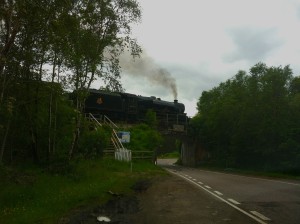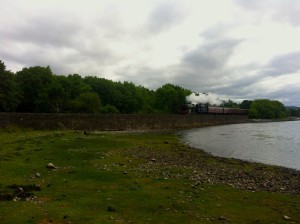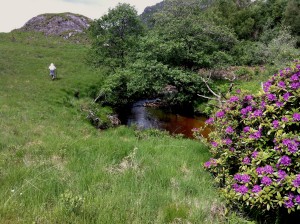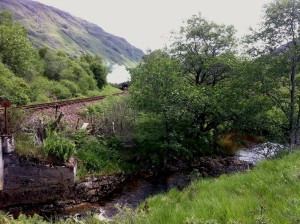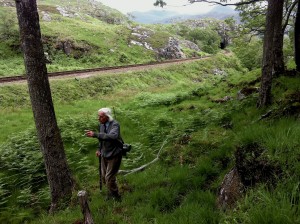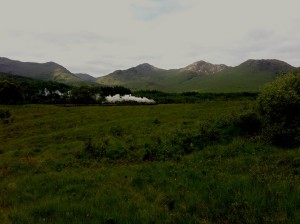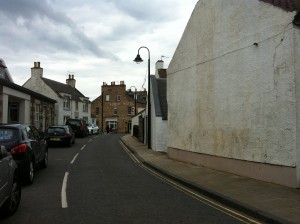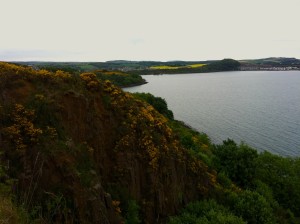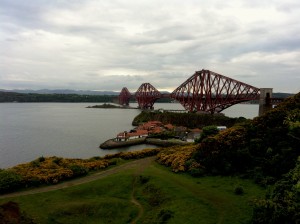Trainspotting the Scottish Highlands
We leave at 5.30 in the morning from North Queensferry. I sleep in the front seat until we begin winding through the start of the highlands, the hills are dramatic as they rise and fall as far as the eye can see. Our arrival at Fort William is simply to scope out the engine, shunting on the tracks: Black 5 no. 45407, the Jacobite, built in 1936-7 for LMS (London-Midlands-Scotland) in Crewe, privately owned and contracted to West Coast Railways for the six-month tourist season to run from Fort William to Mallaig. It’s a gorgeous engine, shining black steel, massive cast iron wheels connected by forged steel simple-linkage rods, healthy exhaust as the train primes.
We set off to Corpach Basin, to have a brisk walk along the lower loch and watch the departure of the train from across the lake. It’s off in perfect time, 10.20 on the dot, steam blowing, a line of exhaust tracing across the cluster of white, fort-like buildings arranged on the hillside that composes Fort William. We reverse direction, pick up the pace and return to the Basin, past the ducks quacking as they skim across the lake and the boats bobbing between the bridges in the canal space of the seventeen lochs, waiting for their chance to rest in the lower loch.
A crowd is gathered in the parking lot, cameras at the ready: the engine sails through, giving a whistle of greeting, exhaust beautifully stretched out behind. The windows are full of smiling faces, everyone waving, six red carriages and then it is gone, racing along the lake and out of view. We jump into the car and we’re off in hot pursuit–leaving Coprach and racing through villages, overtaking cars and lauries on the motorway and before long we are next to the train, racing beside it as it flashes though the trees, slowly overtaking the carriages and the engine is barely visible, the powerful barking sound resonating through the air, chugga-chugga-chugga, the exhaust billowing and the red bodies of the carriages flashing, windows perfectly placed inside them, faces seemingly frozen beside us as our speed matches and the route changes, the train disappears behind the hill and we are alone, racing on the road, buried in the trees.
We race on. “A turn on the right, and the lay-by just after it,” John repeats to himself, a road flashes by on the right and he slams on the brakes: “Seatbelt off, dearie, saves a few milliseconds,” and we pull off the road at Fassfarn, jump out of the car and John grabs his camera, we jump over the fence, race across the track, clamber over the second fence and we are in a field, sheep grazing to the right and Loch Eil stretches up to the base of the railway on the right. “We’ve got a few seconds here,” John tells me, and, “Oh, look at that spot of sun!” and he is visibly excited, walking in his rushed, bouncing gait to stand beneath a tree and situate himself with his camera.
The sound reaches us first, a-chugga-chugga-chugga, the engine is working and for nearly a minute we are bouncing with excitement and anticipation: a glimpse of exhaust in the trees in the distance and, “Wah-hoo! There it is!” and the engine races beautifully out of the woods towards us, the sounds and the sight and the sun peeks out and it races past, faces waving in the windows and we are buried in the field, laughing and waving as it races by.
“Very good, carry on,” says John and we race back over the fences, across the tracks and back to the road where we rush on, eating wine-gums and hooting and hollering and laughing, racing down the sprawling roads and John starts chatting and drives slightly slower and we miss it at Craigag bridge, getting just a glimpse of the tail end as it races along the hillside and into the trees out of sight and we speed along. “We’ll catch it tomorrow!” I exclaim with a whoop.
We race on to Glenfinnan, where all the tourists are clustered at the base of the hill: John drops me off at the edge of the parking lot and I sprint out of the car, laughing and running in sheer exhilaration, and just as the train reaches the start of the viaduct in the distance it slows down, lets out a stream of exhaust and whistles for the crowd, everyone cheers and as it disappears on the other side of the epic valley I race back to John, jump in the car, and we’re off again.
And so it goes, for three days, chasing the trains from Fort William to Mallaig and back again, climbing through the wild, rugged highlands, making our way through ferns and boggy mosses, over the cliffs to see hidden parts of the railway, pruning back the trees that distract the view of the train: being eaten by midges, searching for ticks, no time for food in the day as we race after the morning train and afternoon train and in the evening we enjoy meals of fresh seafood or fish and chips before I go to rest in the Bed & Breakfast and John drives off to sleep in the car and bathe in the river, he enjoying his ‘wild living’ as I bask in the glorious luxury of a hot shower, a brief time of quiet and rest before a proper breakfast early in the morning and the call of the whistle to roil our blood and entice us to follow.
“It’s super! It’s wonderful! It’s excellent!” John yells in his excited English accent, pumping his fist in the air, reaching and exceeding the speed limit for the first time since I’ve met him. “It’s all in the chase! Who-hoo! Just knowing it’s coming! Who-hoo! Oh, wonderful, dear. Just wonderful. Fantastic! Ho-ho! Who-hoo!”
And I giggle and whoop and holler along with him, and roll down the window for the refreshing flood of energy that accompanies the pursuit of the barking and whistling steam engine.
